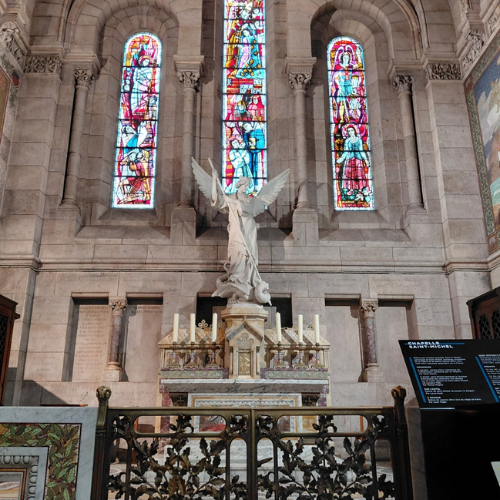Holy Relics, Sacred Art, and Forms of Faith ~Misty Urban
My dad likes to send me updates on books he’s reading about the foundation and early days of Christianity. As philosophers and historians, he and I are both fascinated by how the words spoken by a man who walked the earth 2,000 years ago can reach across vast changes in technology and culture to still have relevance today.
In June, Clio and I traveled to several cities in western Europe, and in visiting the churches and medieval museums, I was awed by contemplating the enormous ways in which people have honored and communicated their faith. We lit candles in the Brussels Cathedral and Sacre Coeur in Montmartre. We saw how reconstruction is proceeding on Notre Dame of Paris. I dragged her to the Musée de Cluny, the national museum of medieval art, and we saw the statues of the Biblical kings that were torn off the façade of Notre Dame during the French Revolution (the patriots opposed the idea of a state religion). I saw a Book of Hours printed in 1498. I saw a reliquary of the Virgin and Child that was made to hold—I kid you not—the Holy Umbilical Cord. (Not many places claimed to hold a piece of the Holy Umbilical Cord; according to the placard, this is the only surviving example in France.)
Of course, as Protestants, we have access to Christ without the intercession of saints or divine relics. But nevertheless, I’m fascinated by the means people construct to approach and honor the divine. The soaring roofs of cathedrals were meant to fill one with reverence and draw the eye to heaven. The statues of saints and angels were touchstones, places one could send up a prayer and believe it would be heard. Books of Hours were intended to guide the reader—and those listening to the reader—through prayerful reflection. And relics, with their holy power, provided spiritual fortification. I enjoyed encountering all these demonstrations of faith, and I enjoyed remembering I have access to Jesus through the simple power of prayer.
I’m not worried that faith is going to disappear from our world. Religious observance changes over time, of course, as people discover what methods of connection matter most to them. Part of what I love about Trinity, especially under the pastoral care of Rev. Kevin, is the attempt to listen to, acknowledge, and support the many and varied ways people want to celebrate their faith and enjoy the church. Some of us want quiet, prayerful reflection and reverence. Some of us want to make a joyful noise. Some of us want the holy symbols and incense, and some of us prefer contemplation through meditation, Celtic-inspired service, or listening to beautiful music.
I’m a member of Trinity precisely because of this continued embrace of, and genuine interest in, our differences and individuality. I’m also a member of Trinity because of the loving communion that takes place here every week—every day, really. I believe that all of us want to be fortified; all of us want to feel we are held by and connected to something greater than ourselves. We come to feel guided and nourished by the reminder of how Jesus wants us to live in relationship with Him and with the world around us. We come for the reminder that the church—which is us—will continueas long as we love and are kind to one another.
I hope you, too, dear reader, feel at home at Trinity, and if you have ideas about how you would like to practice your faith, or other ideas about how to add to our worship or mission, I hope you will tell a vestry member or Rev. Kevin. Our real work, after all, is not the preservation of a building or the enactment of a ritual, but to support the walk of faith for every seeker. Jesus’s words survive because the advice is sound and quite simple: Love and serve. Be kind and help others. Bring the kids.
May your faith always be a source of joy.
-Misty Urban

